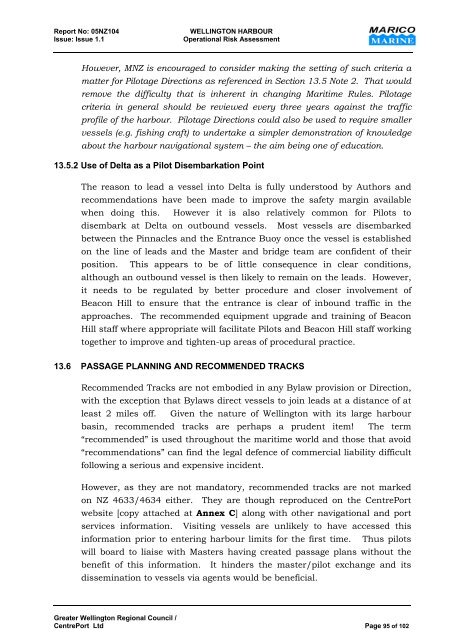MARICO Marine NZ Limited WELLINGTON HARBOUR PORT AND ...
MARICO Marine NZ Limited WELLINGTON HARBOUR PORT AND ...
MARICO Marine NZ Limited WELLINGTON HARBOUR PORT AND ...
You also want an ePaper? Increase the reach of your titles
YUMPU automatically turns print PDFs into web optimized ePapers that Google loves.
Report No: 05<strong>NZ</strong>104 <strong>WELLINGTON</strong> <strong>HARBOUR</strong><br />
Issue: Issue 1.1 Operational Risk Assessment<br />
However, M<strong>NZ</strong> is encouraged to consider making the setting of such criteria a<br />
matter for Pilotage Directions as referenced in Section 13.5 Note 2. That would<br />
remove the difficulty that is inherent in changing Maritime Rules. Pilotage<br />
criteria in general should be reviewed every three years against the traffic<br />
profile of the harbour. Pilotage Directions could also be used to require smaller<br />
vessels (e.g. fishing craft) to undertake a simpler demonstration of knowledge<br />
about the harbour navigational system – the aim being one of education.<br />
13.5.2 Use of Delta as a Pilot Disembarkation Point<br />
The reason to lead a vessel into Delta is fully understood by Authors and<br />
recommendations have been made to improve the safety margin available<br />
when doing this. However it is also relatively common for Pilots to<br />
disembark at Delta on outbound vessels. Most vessels are disembarked<br />
between the Pinnacles and the Entrance Buoy once the vessel is established<br />
on the line of leads and the Master and bridge team are confident of their<br />
position. This appears to be of little consequence in clear conditions,<br />
although an outbound vessel is then likely to remain on the leads. However,<br />
it needs to be regulated by better procedure and closer involvement of<br />
Beacon Hill to ensure that the entrance is clear of inbound traffic in the<br />
approaches. The recommended equipment upgrade and training of Beacon<br />
Hill staff where appropriate will facilitate Pilots and Beacon Hill staff working<br />
together to improve and tighten-up areas of procedural practice.<br />
13.6 PASSAGE PLANNING <strong>AND</strong> RECOMMENDED TRACKS<br />
Recommended Tracks are not embodied in any Bylaw provision or Direction,<br />
with the exception that Bylaws direct vessels to join leads at a distance of at<br />
least 2 miles off. Given the nature of Wellington with its large harbour<br />
basin, recommended tracks are perhaps a prudent item! The term<br />
“recommended” is used throughout the maritime world and those that avoid<br />
“recommendations” can find the legal defence of commercial liability difficult<br />
following a serious and expensive incident.<br />
However, as they are not mandatory, recommended tracks are not marked<br />
on <strong>NZ</strong> 4633/4634 either. They are though reproduced on the CentrePort<br />
website [copy attached at Annex C] along with other navigational and port<br />
services information. Visiting vessels are unlikely to have accessed this<br />
information prior to entering harbour limits for the first time. Thus pilots<br />
will board to liaise with Masters having created passage plans without the<br />
benefit of this information. It hinders the master/pilot exchange and its<br />
dissemination to vessels via agents would be beneficial.<br />
Greater Wellington Regional Council /<br />
CentrePort Ltd Page 95 of 102
















